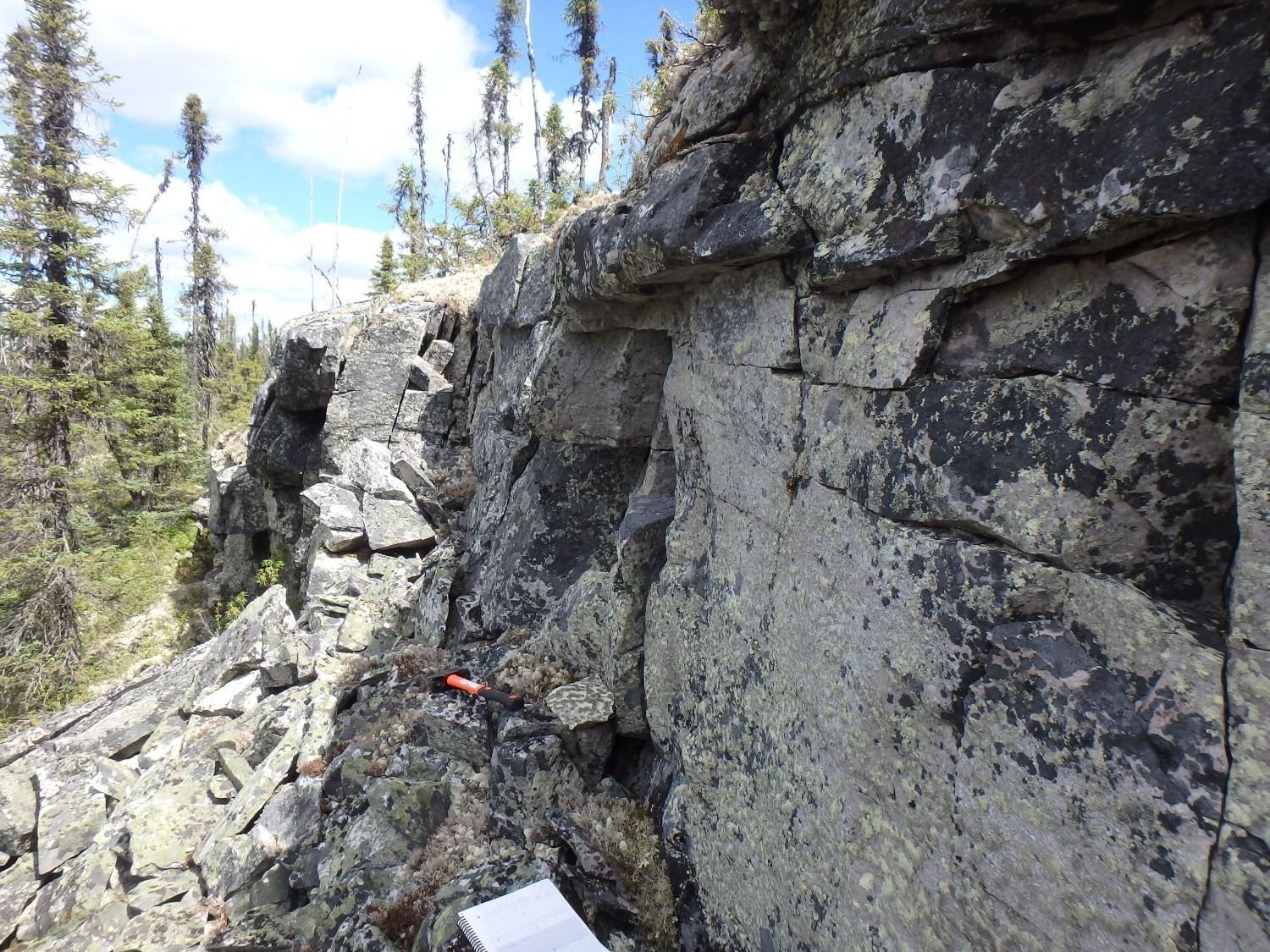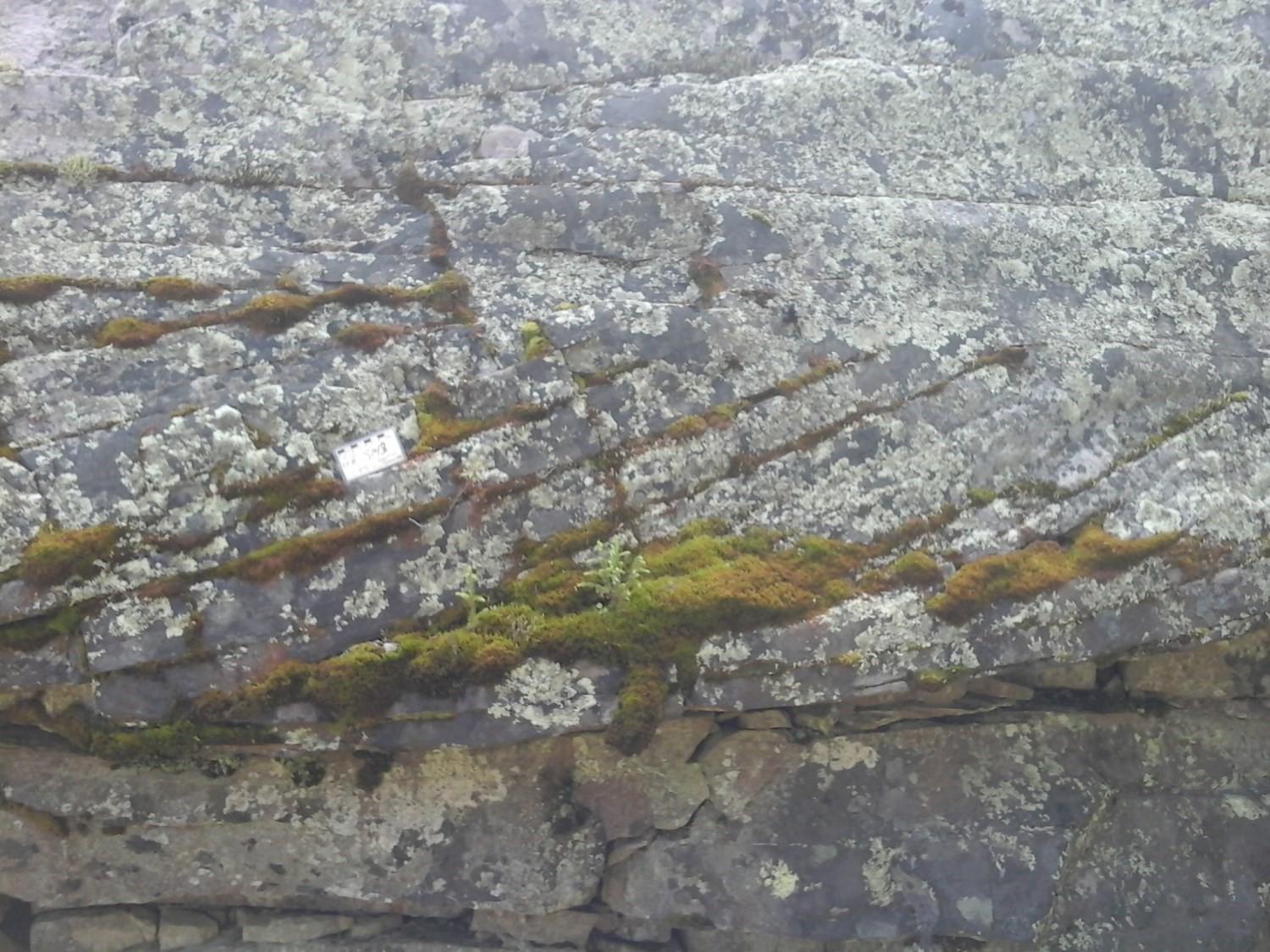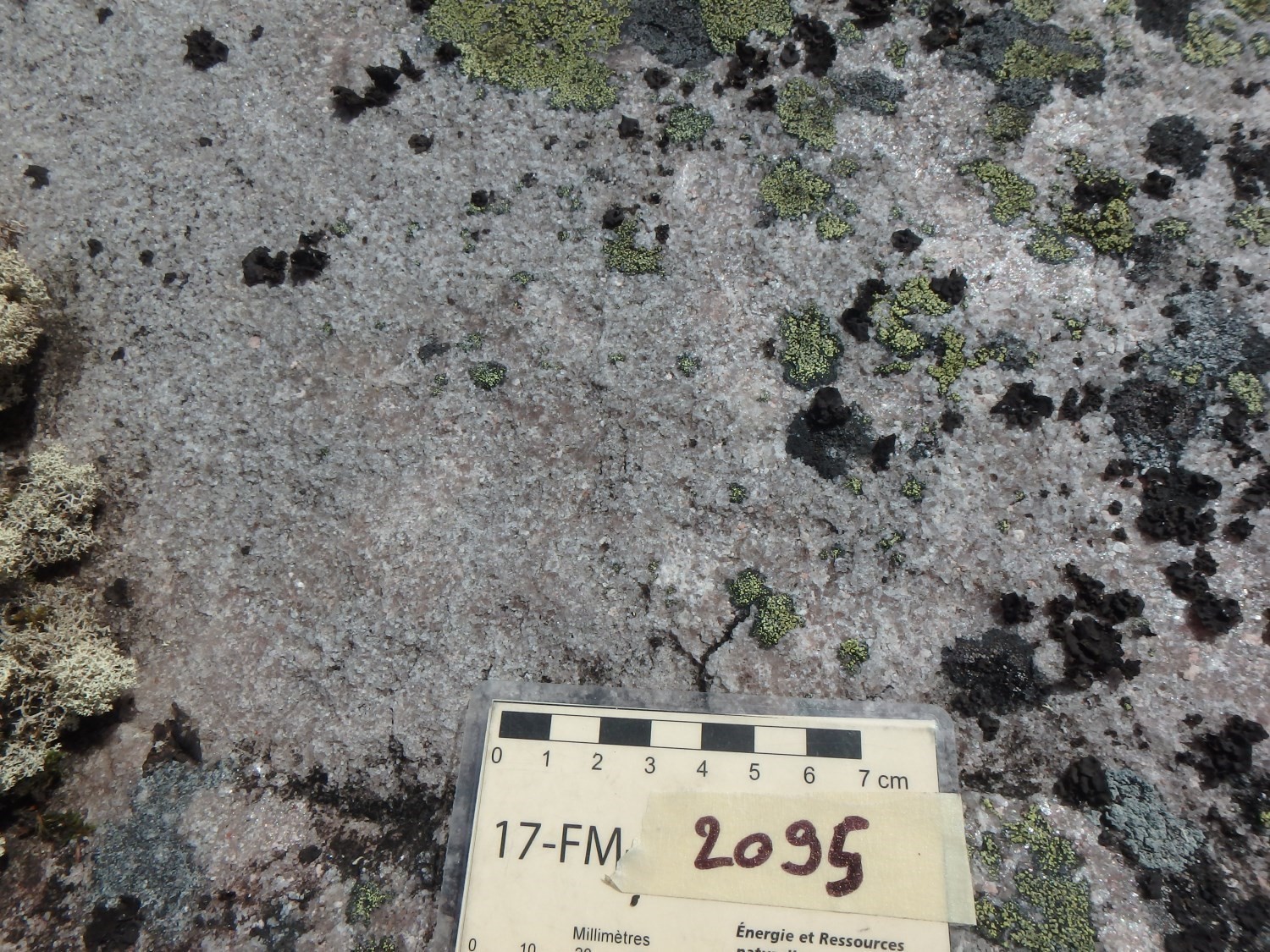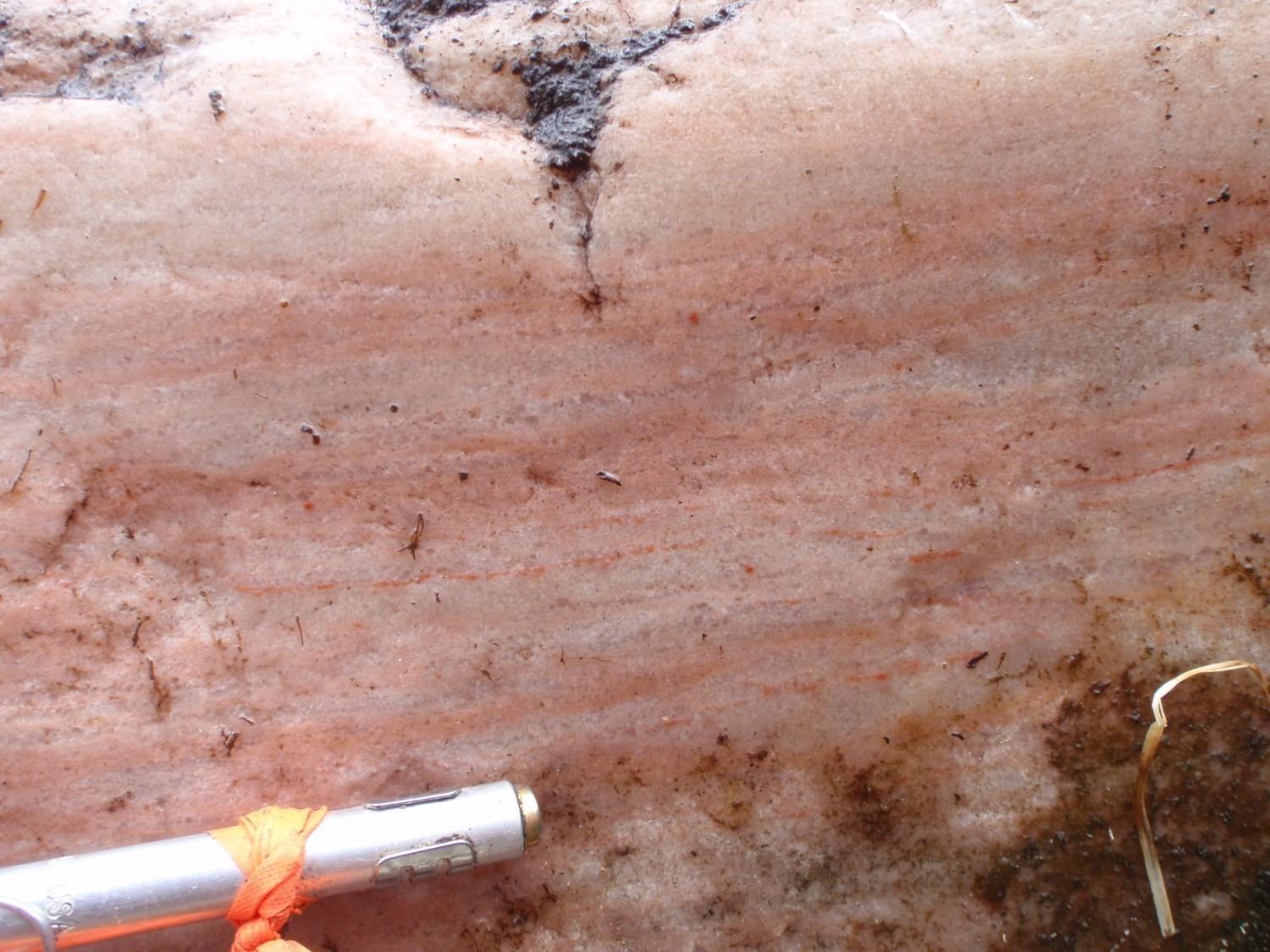
DISCLAIMER: This English version is translated from the original French. In case of any discrepancy, the French version shall prevail.
| Author(s): | Genest, 1989 |
| Age: | Paleoproterozoic |
| Stratotype: | Type section of the Indicator Formation (now Indicator Group) of Chown and Caty (1973) located on the north face of the hill north of Conflans Lake (52º26’N, 70º47’W) |
| Type area: | Conflans Lake area (NTS sheet 23D07) |
| Geological province: | Superior Province |
| Geological subdivision: | Opatica Subprovince |
| Lithology: | Conglomerate, conglomeratic sandstone and sandstone |
| Category: | Lithostratigraphic |
| Rank: | Formation |
| Status: | Formal |
| Use: | Active |
Background
The « Matoush Formation » was established by Genest (1989) and refers to a lake in NE Otish Basin (sheet 23D07) named in honour of the Matoush family in the village of Mistissini. The Matoush Formation corresponds to the first three units described by Chown and Caty (1973) in the type section of the Indicator Formation, later elevated to the rank of group by Genest (1989). Correlations between the different nomenclature used in previous work are summarized in the Otish Supergroup record and in the summary table of Genest (1989, p. 21). The Ministère‘s compilation maps (2010a-c) are essentially based on descriptions from Genest (1989), which are summarized in the following section.
Description
The Matoush Formation consists of conglomerate, pebble or cobble conglomeratic sandstone and sandstone. Genest (1989) divided the formation into two separate members, Member A for basal conglomerates and pebble and cobble conglomeratic sandstone, and Member B for sandstone. These divisions are not used here.
The base of the formation is characterized by polymictic conglomerate with fragments of volcanic rocks from underlying Archean bedrock. This lithology gradually changes to the main basal quartz pebble or cobble oligomictic conglomerate. South of Indicateur Lake, a 22 m thick section exposing this conglomerate shows that the maximum clast size decreases from 40 cm at the base to 4 cm at the top, while the quantity of quartz fragments increases from 1% to 80% (Genest, 1986). Conglomerate is beige to light green and mainly arkosic in composition. Fragments are generally rounded and vary widely in size from one area to another, 4 to 50 cm for quartz fragments and up to 1 m for metavolcanic rock fragments. Some conglomerate beds also contain angular fragments of quartz and feldspar up to 2.5 cm. K-feldspar (orthose and microcline) is characterized by an argillaceous alteration (illite and kaolinite).
Quartz pebble conglomerate gradually changes to pebbly conglomeratic sandstone containing a few thin conglomerate beds. A few beds of sandstone and greenish siltstone are also interstratified in conglomerate and pebbly conglomeratic sandstone.
The upper part of the Matoush Formation displays alternating medium to very coarse-grained sandstone, laminated or massive, locally containing granules. Sandstone is feldspathic or arkosic, beige, greenish, pink or grey. It is mainly composed of subrounded quartz grains and diagenetically altered K-feldspar, which increases the percentage of the clay fraction. The sandstone sequence also contains several thin beds of greenish beige silt/clay sandstone.
Several elements suggest depositional conditions in reductive environments, such as a pyrite-bearing layer associated with uranium mineralization, cubic dissolution cavities (pyrite remnants) with limonitization halos, some beds displaying pink banding and detrital pyrite fragments in basal polymictic conglomerate.
The stratotype of the Matoush Formation is described by Chown and Caty (1973) in the type section of the Indicator Formation (now Indicator Group) on the north side of the hill north of Conflans Lake:
| Unit |
Interval (m) |
Description |
| Shikapio Formation | 245 | Base of Gabbro Sill (estimated 61 m of sandstone above sill). |
| 204-245 | Buff, pink and white, well-sorted arkose and subarkose, well laminated and cross-laminated. Thin red argillite beds, minor covered intervals. | |
| 193-204 |
Buff, white and pink pebbly arkosic conglomeratic sandstone and quartz pebble conglomerate, poorly sorted, minor sandstone. |
|
| Matoush Formation | 137-193 | Buff, pink and grey sandstone moderate to well sorted, subarkose and arkose. Well-laminated, minor cross-laminations. Minor covered intervals. |
| 70-137 | Cream to buff partly sorted pebbly conglomeratic sandstone. Intercalated grey and cream well-sorted arkosic sandstone, very few quartz-pebble conglomerate beds (73-96 m covered interval). | |
| 0-70 | Cream to buff quartz pebble conglomerate and pebbly conglomeratic arkose, poorly sorted, massive beds. Conglomerate content decreases up- section. Some quartz cobble conglomerate beds near base of section. | |
| 0 | Approximately 30 m covered interval to granite outcrop below. |
Thickness and distribution
The Matoush Formation is located throughout the Otish Basin. It occurs in two main discontinuous strips generally orientated NE-SW (northern portion of sheet 22M and southern half of sheet 23D) on the periphery of a regional syncline. These strips vary in width from approximately 1 km to 8 km. The thickness of the basal conglomerate sequence (Member A of Genest, 1989) varies from 15 to 390 m, and the thickness of the sandstone sequence (Member B of Genest, 1989) varies from 10 m to 181 m, reaching 310 m locally.
Dating
The Matoush Formation is cut by gabbro dykes and sills associated with the Otish Gabbro dated to 2169 Ma (Hamilton and Buchan, 2016; Miligragovic et al., 2016), giving it a minimum sedimentation age.
Stratigraphic Relationship(s)
Sedimentary rocks of the Matoush Formation unconformably overlie the regolitized Archean basement (Chown and Caty, 1973; Caty, 1976; Chown and Caty, 1983) and are conformably overlain by the Shikapio Formation. The Matoush Formation is cut by gabbro dykes and sills associated with the Otish Gabbro.
Paleontology
Does not apply.
References
Publications Available Through SIGÉOM Examine
CATY, J.L. 1976. STRATIGRAPHIE ET SÉDIMENTOLOGIE DE LA FORMATION PAPASKWASATI DE LA RÉGION DU LAC MISTASSINI, QUÉBEC. MRN. DPV 423, 288 pages.
GENEST, S. 1986. GÉOLOGIE DE LA RÉGION DU LAC INDICATEUR (TERRITOIRE DU NOUVEAU-QUÉBEC). MRN. ET 86-04, 29 pages and 1 plan.
MRNF. 2010a. CARTE(S) GÉOLOGIQUE(S) DU SIGÉOM – feuillet 22M. CG SIGEOM22M, 16 plans.
MRNF. 2010b. CARTE(S) GÉOLOGIQUE(S) DU SIGÉOM – feuillet 23D. CG SIGEOM23D, 16 plans.
MRNF. 2010c. CARTE(S) GÉOLOGIQUE(S) DU SIGÉOM – feuillet 32P. CG SIGEOM32P, 16 plans.
Other Publications
Chown, E.H., Caty, J.-L. 1973. Stratigraphy, petrography and paleocurrent analysis of the Aphebian clastic formations of the Mistassini-Otish Basin. In Huronian stratigraphy and sedimentation. Edited by G.M. Young. Geological Association of Canada; Special Paper 12, pages 49-71.
Chown, E.H., Caty, J.L. 1983. Diagenesis of the Aphebian Mistassini regolith, Quebec, Canada. Precambrian Research; volume 19, pages 285-299. https://doi.org/10.1016/0301-9268(83)90017-7
Genest, S. 1989. Histoire géologique du Bassin d’Otish, protérozoïque inférieur (Québec). Université de Montréal, doctoral thesis, 334 pages.
Hamilton, M.A., Buchan, K.L. 2016. A 2169 Ma U–Pb baddeleyite age for the Otish Gabbro, Quebec: implications for correlation of Proterozoic magmatic events and sedimentary sequences in the eastern Superior Province. Canadian Journal of Earth Sciences; 53, pages 119-128. https://doi.org/10.1139/cjes-2015-0131
Miligragovic, D., Beaudoin, G., Hamilton, M.A., King, J.J. 2016. The Paleoproterozoic Otish Gabbro suite and coeval dyke swarms of the Superior Province: Probing the ca. 2.17Ga mantle. Precambrian Research; 278, pages 126-144. https://doi.org/10.1016/j.precamres.2016.03.012
Suggested Citation
Ministère de l’Énergie et des Ressources naturelles (MERN). Matoush Formation. Quebec Stratigraphic Lexicon. https://gq.mines.gouv.qc.ca/lexique-stratigraphique/province-du-superieur/formation-de-matoush_en [accessed on Day Month Year].
Contributors
|
First publication |
Céline Dupuis, P. Geo., Ph.D. céline.dupuis@mern.gouv.qc.ca (redaction) Mehdi A. Guemache, P. Geo., Ph.D. (coordination); Claude Dion, Eng., M.Sc. (critical review and editing); Céline Dupuis, P. Geo., Ph.D. (English version); André Tremblay (HTML editing). |





